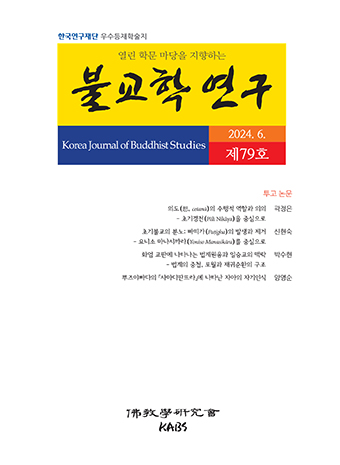Abstract
References
Sorry, not available.
Click the PDF button.
Information
Scholars of the Madhyamaka school such as Piṅgala 靑目 andCandrakīrti 月稱 define the middle way 中道 as neither existingnor non-existing 非有非無, while those in the Sanlun school suchas Jízàng 吉藏 define the middle way as neither empty nor existing非空非有. Therefore, I raise the question of why the two schoolsdefine the middle way in different terms. To answer this question,I conduct comparative considerations on the three theories ofdependent origination 緣起說, the middle way 中道說, and twotruths 二諦說 between the two schools. To sum up the answers,they are as follows. The common features in the three theories of the two schoolsare found in that they use the theory of dependent origination as alogical and practical tool for illuminating the truth of the middleway and helping the achievement of Nirvāṇa, and in that theyboth claim the middle way is undiscriminable 無所得 and neither speakable nor thinkable 言忘慮絶, upon a background of absolutenon-attachment. From such common features, it is clear thatthe three theories of the two schools agree at a basic level eventhough they are different in their terms of expression. I believe it islikely that this difference of expression arose from differences ofideological circumstance. The differences in the three theories of the two schools are foundin that although Madhyamaka scholars say that the highest truth勝義諦 is beyond language and knowledge, Sanlun scholars saythe two truths are interdependent 相互依存, and so they are merethe assumed names 假名 and the teachings 言敎. Another is foundin that while the Madhyamaka school states that dependentlyoriginated things are neither same nor different 不一不異, theSanlun school says that they are non-dual 不二 and identical 相卽. Jízàng makes a contradictory claim that although the two truthsare interdependent, and so they are mere the assumed names andthe teachings, nevertheless the highest truth or middle way isundiscriminable and neither speakable nor thinkable. Because theundiscriminable and the neither speakable nor thinkable cannotbe interdependent, so it cannot be the assumed name or theteaching. Yet, this contradiction can be explained in the followingmanner. It is to think that Jízàng regarded all of the various highesttruths and middle ways which other schools assert, are mere theassumed names and the teachings, and so they are interdependent, but the highest truth or middle way of the Sanlun school is theundiscriminable and the neither speakable nor thinkable. I believe that Jízàng's idea that dependently originated thingsare identical created a strong impression on Chinese Buddhismafterwards, but this remains a further area for investigation.
논자는 본 논문에서 중관학파인 청목과 월칭 등이 중도를 비유비무(非有非無)라고 정의함에 대하여, 삼론학파인 길장은 중도를 비공비유(非空非有)라고 정의함에 주목하여, ‘삼론학파가 중도를 중관학파와 다른 형식으로 정의하는 이유는 무엇인가?’라는 의문을 제기하고,용수, 청목, 월칭, 길장을 중심으로 양 학파의 연기설과 중도설 및 이제설을 비교해서 고찰함으로써, 그런 의문에 대한 답변을 찾아보고자 하였다. 양 학파의 연기설과 중도설 및 이제설에서 공통성은 연기설을 중도의 진실을 밝히고 열반의 성취를 돕는 논리적이고 실천적인 도구로 사용하였다는 점과 철저한 무집착을 바탕으로 하는 무소득과 언망려절의 중도 개념에서 발견되며, 그와 같은 공통성으로부터 양 학파가 설하는 연기설과 중도설 및 이제설은 그 표현 방식은 다르지만, 배경이되는 근본 사상은 일치하는 것을 알 수 있다. 그리고 그와 같은 표현 방식의 차이는 양 학파의 사상적 주변 상황의 차이에서 기인하는 것이라고 생각된다. 양 학파의 연기설과 중도설 및 이제설에서 차별성은 중관학파가 승의제를 언어와 지식의 작용을 떠난 것이라고 설함에 대하여, 삼론학파는 이제가 상호의존하는 것이고, 가명이며, 가르침이라고 주장하는 곳에서, 그리고 중관학파가 연기인 것을 불일불이라고 설함에 대하여, 삼론학파는 연기인 것을 불이와 상즉이라고 주장하는 곳에서 발견된다. 양 학파의 공통성과 차별성에서 진제와 중도를 무소득과 언망려절이라고 설하면서도, 다른 한편으로는 이제가 상호의존하는 것이고, 가명이며, 가르침이라고 주장하는 길장의 이중적인 태도는 다음과 같은 방법으로 설명할 수 있다. 즉 타 학파가 주장하는 여러 종류의 진제와 중도는 모두 언어로 설해진 것이기 때문에, 상호의존하는 것으로서 가명인 동시에 가르침에 해당하고, 삼론학파가 설하는 진제와 중도는 무소득과 언망려절의 진제와 중도에 해당한다는 것이다. 양 학파의 차별성에서 연기인 것을 상즉이라고 설하는 길장의 사고는 그 이후의 중국불교에 큰 영향을 미쳤다고 생각되지만, 그 구체적인 내용은 본고에서 다루지 못하였다. 그에 대한 자세한 고찰은 다음기회로 미룬다.
Click the PDF button.
- Publisher :Korean Association of Buddhist Studies
- Publisher(Ko) :불교학연구회
- Journal Title :Korea Journal of Buddhist Studies
- Journal Title(Ko) :불교학연구
- Volume : 38
- No :0
- Pages :137 ~ 184


 Korea Journal of Buddhist Studies
Korea Journal of Buddhist Studies






